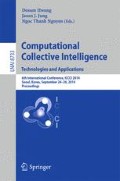Abstract
In this paper we introduce a new variant of splicing systems, called fuzzy splicing systems, and establish some basic properties of language families generated by this type of splicing systems. We study the “fuzzy effect” on splicing operations, and show that the “fuzzification” of splicing systems can increase and decrease the computational power of splicing systems with finite components with respect to fuzzy operations and cut-points chosen for threshold languages.
Access this chapter
Tax calculation will be finalised at checkout
Purchases are for personal use only
Preview
Unable to display preview. Download preview PDF.
References
Adleman, L.: Molecular computation of solutions to combinatorial problems. Science 266, 1021–1024 (1994)
Boneh, D., Dunworth, C., Lipton, R., Sgall, J.: On the computational power of DNA. Discrete Applied Mathematics. Special Issue on Computational Molecular Biology 71, 79–94 (1996)
Lipton, R.: Using DNA to solve NP–complete problems. Science 268, 542–545 (1995)
Head, T.: Formal language theory and DNA: An analysis of the generative capacity of specific recombination behaviors. Bull. Math. Biology 49, 737–759 (1987)
Pixton, D.: Regularity of splicing languages. Discrete Applied Mathematics 69, 101–124 (1996)
Pǎun, G., Rozenberg, G., Salomaa, A.: DNA computing. New computing paradigms. Springer-Verlag (1998)
Mordeson, J., Malik, D.: Fuzzy Automata and Languages. Theory and Applications. Chapman & Hall/CRC (2002)
Dassow, J., Pǎun, G.: Regulated rewriting in formal language theory. Springer-Verlag, Berlin (1989)
Rozenberg, G., Salomaa, A.: Handbook of formal languages, vol. 1-3. Springer, Heidelberg (1997)
Author information
Authors and Affiliations
Editor information
Editors and Affiliations
Rights and permissions
Copyright information
© 2014 Springer International Publishing Switzerland
About this paper
Cite this paper
Karimi, F., Turaev, S., Sarmin, N.H., Fong, W.H. (2014). Fuzzy Splicing Systems. In: Hwang, D., Jung, J.J., Nguyen, NT. (eds) Computational Collective Intelligence. Technologies and Applications. ICCCI 2014. Lecture Notes in Computer Science(), vol 8733. Springer, Cham. https://doi.org/10.1007/978-3-319-11289-3_3
Download citation
DOI: https://doi.org/10.1007/978-3-319-11289-3_3
Publisher Name: Springer, Cham
Print ISBN: 978-3-319-11288-6
Online ISBN: 978-3-319-11289-3
eBook Packages: Computer ScienceComputer Science (R0)

